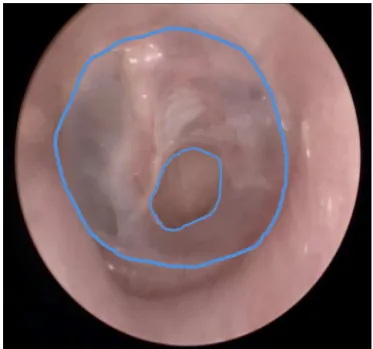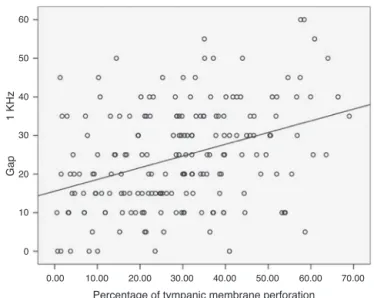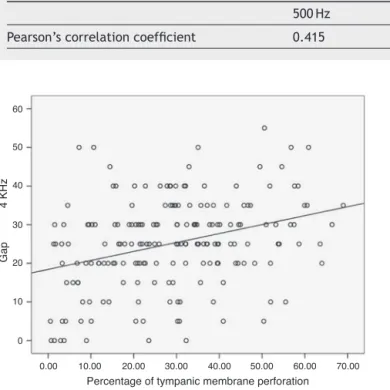BrazJOtorhinolaryngol.2014;80(5):386---389
Brazilian
Journal
of
OTORHINOLARYNGOLOGY
www.bjorl.org
ORIGINAL
ARTICLE
Objective
comparison
between
perforation
and
hearing
loss
夽
,
夽夽
Fernando
de
Andrade
Quintanilha
Ribeiro
a,∗,
Verônica
Reche
Rodrigues
Gaudino
b,
Caio
Dinelli
Pinheiro
b,
Gil
Junqueira
Marc
¸al
b,
Edson
Ibrahim
Mitre
baDepartmentofOtorhinolaryngology,FacultyofMedicalSciences,SantaCasadeSãoPaulo(FCMSCSP),SãoPaulo,SP,Brazil bFacultyofMedicalSciences,SantaCasadeSãoPaulo(FCMSCSP),SãoPaulo,SP,Brazil
Received19October2013;accepted22March2014 Availableonline23July2014
KEYWORDS
Evaluation;
Tympanicmembrane
perforation; Hearingloss
Abstract
Introduction:Thereappearstobenorelationshipbetweenthesizeoftympanicperforations andhearingloss.Somestudiesintheliteraturehaveassessedthisconnection,withconflicting dataandwithoutpropermethodology,especiallyconcerningthemeasurementofthesizeof theperforation,whichwasperformedinasubjectivemanner.
Objective:Toevaluatethesizeoftympanicperforationsandtorelatethemtohearinglossin fourdifferentsoundfrequenciesthroughtheuseofanobjectivemethod.
Methods:Transversalretrospectivestudy.Thepresentstudyevaluated187perforationsthrough digitalimaging,calculated thepercentagesofthetympanicmembranethatwasperforated usingImageScopesoftwareversion11.1.2.760andcorrelatedperforations’sizewithhearing lossatfourfrequencies.
Results:DatawerestatisticallyanalyzedusingPearson’scorrelationtest.
Conclusion:Therewas nosignificantrelationship betweenthesizeoftympanicperforations andhearinglossinthefouranalyzedfrequencies.
© 2014Associac¸ãoBrasileira de Otorrinolaringologiae CirurgiaCérvico-Facial. Publishedby ElsevierEditoraLtda.Allrightsreserved.
夽 Pleasecitethisarticleas:RibeiroFA,GaudinoVR,PinheiroCD,Marc¸alGJ,MitreEI.Objectivecomparisonbetweenperforationand
hearingloss.BrazJOtorhinolaryngol.2014;80:386---9.
夽夽
Institution:FacultyofMedicalSciences,SantaCasadeSãoPaulo,SãoPaulo,SP,Brazil. ∗Correspondingauthor.
E-mail:quintanilha.f@uol.com.br(F.A.Q.Ribeiro).
http://dx.doi.org/10.1016/j.bjorl.2014.07.007
Objectivecomparisonbetweenperforationandhearingloss 387
PALAVRAS-CHAVE
Avaliac¸ão; Perfurac¸ãoda
membranatimpânica;
Perdaauditiva
Comparac¸ãoobjetivaentreperfurac¸ãotimpânicaeperdaauditiva
Resumo
Introduc¸ão: Parecenãohaverrelac¸ãoentreotamanhodasperfurac¸õestimpânicaseaperda auditiva.Algunstrabalhosnaliteraturaestudaramestarelac¸ão,comdadosconflitantesesem usoadequadodametodologiaempregada,principalmentequanto àmedic¸ãodotamanhoda perfurac¸ãoquesefazdemodosubjetivo.
Objetivo: Analisaratravésdeummétodoobjetivootamanhodessasperfurac¸õeserelacioná-las comperdasauditivasemquatrofrequênciassonoras.
Método: Estudoretrospectivodecortetransversal.Foramavaliadas187perfurac¸ões timpâni-cas através de digitalizac¸ão de imagem, medidas porcentualmente como uso do software ImageScopeVersion11.1.2.760ecorrelacionadascomoslimiaresauditivosemquatro frequên-cias.
Resultados: Osdadosforamavaliadosestatisticamentepelotestedecorrelac¸ãodePearson, quenãodemonstroucorrelac¸ãoentreotamanhodaperfurac¸ãotimpânica eograudeperda auditiva.
Conclusão:Nãohárelac¸ãosignificativaentreotamanhodasperfurac¸õestimpânicaseasquatro frequênciasestudadas.
©2014Associac¸ãoBrasileiradeOtorrinolaringologiaeCirurgiaCérvico-Facial.Publicado por ElsevierEditoraLtda.Todososdireitosreservados.
Introduction
Thiswasalongitudinalretrospectivecohortstudy.Itisclear
that there appears to be no direct relationship between
thesizeofthetympanicmembraneinsimplechronicotitis
media and hearing loss assessed by pure tone
audiome-try. This suspicion has been studied and evaluated, but
by using subjective methods to measure the size of the
perforations.1---5Withtheadventofmoderncomputer
pro-grams,thepercentageoftheseperforationsin relationto
thetotalareaofthemembrane canbeobjectively
evalu-ated. These more accuratedata can be usedtocompare
morereliablythisfindingwitheachaudiometryfrequency. Fewsimilarstudieswereretrievedintheliterature.6,7This
study aimed toanalyze the correlation between the
per-centual size of the perforation and hearing loss in four
frequencies.
Methods
This was a retrospective cohort trial conducted at the
Department of Otorhinolaryngology of a medicalteaching
institution, approved by the Research Ethics Committee
under N◦ 9228. Images of the tympanic membrane were
acquiredusinga3mmdiameterrigidfiberoptictelescope coupledtoadigitalcameraandwithcomputerdigital cap-ture.
Only pictures of simple chronic otitis media (dry
per-forationsassequelae ofnecrotizing otitis)were selected,
with more than six months without otorrhea reportedby
thepatients.Hearinglossinfourfrequencies(500Hz,1kHz,
2kHz, and 4kHz), withany degree of conductive hearing
loss,wasconsidered.Theaudiometrieswereperformedby
phonoaudiologists,usingtheKatztechnique.8
ImageScope,version11.1.2.760byAperioTechnologies®,
wasused.The selectedimageswereevaluatedby
circum-scribing(by tracking witha mouse) the totalarea of the
tympanic membrane, which was then measured by pixel
counting(Fig.1).The sameprocedurewasappliedtothe
areaoftheperforation.Bothmeasuresweretransportedto anExcel®(Microsoft)spreadsheet.Sincethedetermination
oftheareaofperforationwasthencalculatedasa
percent-ageofthe areaof thetympanicmembrane,therewasno
distortionbecauseoftheangleofviewortheproximityof
388 RibeiroFAetal.
Gap
500 Hz
60
50
40
30
20
10
0
0.00 10.00 20.00 30.00 40.00 50.00 60.00 70.00
Percentage of tympanic membrane perforation
Figure2 Correlationbetweenpercentageoftympanic mem-brane perforation and air-bone gap observed at a 500Hz frequency.
theimage capture. These measurementswere performed
bytwoexaminers,at differenttimes,andonlythosethat
coincidedwithanerrorfactorof<5%wereconsidered. Theinclusionandexclusioncriteriaofthestudywereas follows:
- Inclusion --- images of tympanic membrane with
perfo-rationwithout evidenceofinflammation or otorrheafor
more than six months duration, simple chronic otitis
media.
- Exclusion --- evaluation of the perforation size by two
examinerspresentingadifference>5%.
The audiograms were evaluated only with respect to
their conductive hearing loss, i.e. the air-bone gap that
characterized the tympanic involvement (membrane or
ossicular chain). The following frequencies were used:
500Hz,1000Hz,2000Hzand4000Hz.
Data obtained from the perforations of the tympanic
membraneswerecorrelatedwiththeair-bone gapineach
ofthefrequenciesanalyzedbyPearson’scorrelationtest.
Results
Thestudyincluded187earsthatpresentedsimplechronic
otitismedia.Theageofpatientsanalyzedrangedfrom4to 75years.Therightearwasinvolvedin79patients,while108 exhibitedtheprobleminleftear.Thecorrelationbetween thesizeof theperforation andthefrequencies islistedin Table1.
The correlationbetweenthe percentageofperforation
ofthetympanicmembraneandtheair-bonegapthatexists
ineachoftheevaluatedfrequenciesisshowninFigs.2---5. Fig.2illustratesthecorrelationbetweenthepercentage
ofperforationofthetympanicmembraneandtheair-bone
gapobservedatafrequencyof500Hz.
Fig.3showsthecorrelationbetweenthepercentageof
perforationofthetympanicmembraneandtheair-bonegap
observedatafrequencyof1000Hz.
Gap
1
KHz
60
50
40
30
20
10
0
0.00 10.00 20.00 30.00 40.00 50.00 60.00 70.00
Percentage of tympanic membrane perforation
Figure 3 Correlation between the percentage oftympanic membraneperforationandair-bonegapobservedata1000Hz frequency.
Gap
2
KHz
60
50
40
30
20
10
0
0.00 10.00 20.00 30.00 40.00 50.00 60.00 70.00
Percentage of tympanic membrane perforation
Figure 4 Correlation between the percentage oftympanic membraneperforationandair-bonegapobservedata2000Hz frequency.
InFig.4,acorrelationbetweenthepercentageof
per-foration of thetympanic membraneand theair-bone gap
observedinthefrequencyof2000Hzisshown.
Finally,inFig.5,thecorrelationbetweenthepercentage
ofperforationofthetympanicmembraneandtheair-bone
gapobservedatafrequencyof4000Hzisshown.
Discussion
The linear correlation between the size of the tympanic
perforation in patients with simple chronic otitis media
Objectivecomparisonbetweenperforationandhearingloss 389
Table1 Pearson’scorrelationcoefficientfoundforeachfrequencyanalyzed.
500Hz 1000Hz 2000Hz 4000Hz
Pearson’scorrelationcoefficient 0.415 0.372 0.282 0.325
Gap
4
KHz
60
50
40
30
20
10
0
0.00 10.00 20.00 30.00 40.00 50.00 60.00 70.00
Percentage of tympanic membrane perforation
Figure5 Correlationbetweenpercentageoftympanic mem-brane perforation and air-bone gap observed at a 4000Hz frequency.
Thecorrelationforthefrequencyof500Hzwasfoundto bemoderatelysignificantfortheissueexamined,whilethe
correlationsobserved for theother frequencies proved to
beoflittlesignificance.
Intheliterature,Pannuetal.9reporteddifferentresults,
demonstrating an increase in hearing loss with
increas-ingsizes of the tympanicperforation in 100patients who
alsohadperforationswithoutsignsofactiveinflammation
or secretion. Importantly, in that study, the perforation
size was estimated by measuring their greater vertical
(R1) and greater horizontal (R2) diameters with a 1-mm
wire, inserting the values into the formula: perforation
area=×R1×R2.
Ibekwe et al.,10 analyzed 67 patients with a total of
77 perforations. Using the Pearson correlation: p=0.01,
r=0.05,theyconcludedthatthelargerthetympanic mem-braneperforation,thegreaterthelossinsoundperception.
The article by Ahmad and Ramani1 is in agreement
with the studies previously mentioned. In that study, 70
patients with dry central perforation were analyzed. The
patientsweredividedintofourgroupsaccordingtothesize,
expressed as a percentage, of the observed perforation.
Theseauthorsanalyzedthehearinglossineachfrequency
ineachoftheirgroups,andconcludedthatthehearingloss increasedwiththesizeofperforation.
Therefore, thepresent study,with a largernumber of
patientsandusingamoremodernmethodology,contradicts
theliteratureandleadstotheconclusionthatfactors,other thanthesizeofperforation(e.g.,disjunctionsorfixations oftheossicularchain), compromisetheauditoryacuityin patientswithsimplechronicotitismedia.
Conclusion
There was no correlation between the size of tympanic
membraneperforationsinsimple chronicotitismediaand
hearinglossat500Hz;1000Hz;2000Hzand4000Hz.
Conflicts
of
interest
Theauthorsdeclarenoconflictsofinterest.
References
1.AhmadSW,RamaniGV.Hearinglossinperforationsoftympanic membrane.JLaryngolOtol.1979;93:1091---8.
2.VossSE,RosowskiJJ,MerchantSN,PeakeWT.Middle-ear func-tionwithtympanic-membraneperforations.II.Asimplemodel. JAcoustSocAm.2001;110:1445---52.
3.VossSE,RosowskiJJ,MerchantSN,PeakeWT.Middle-ear func-tion withtympanic-membraneperforations. I.Measurements andmechanisms.JAcoustSocAm.2001;110:1432---44. 4.Voss SE, Rosowski JJ, Merchant SN, Peake WT. How do
tympanic-membrane perforations affect human middle-ear soundtransmission?ActaOtolaryngol.2001;121:169---73. 5.Hsu CY, Chen JH, Hwang JH, Liu TC. A computer program
tocalculatethesizeoftympanicmembraneperforation.Clin Otolaryngol.2004;29:340---2.
6.SalibaI, AbelaA, Arand P.Tympanic membraneperforation: size,siteandhearingevaluation.IntJPediatrOtorhinolaryngol. 2011;75:527---31.
7.MehtaRP,RosowskiJJ,VossSE,NeilEO,MerchantSN. Determi-nantsofhearinglossinperforationsofthetympanicmembrane. OtolNeurotol.2006;27:136---43.
8.SchlauchRS,NelsenP.Puretoneevaluation.In:KatzJ,editor. Handbookofclinicalaudiology(chapter30){setascomment}. 6thed.Philadelphia:LippincottWilliams& Wilkins;2009. p. 30---49.
9.PannuKK,ChadhaS,KumarD,PreetiD.Evaluationofhearing lossintympanicmembraneperforation. IndianJOtolaryngol HeadNeckSurg.2011;63:208---13.


